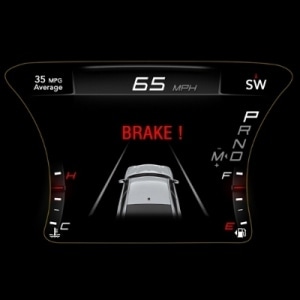Mar 18 2016
FCA US LLC is committing to use sensor-fusion technology for all its future Automatic Emergency Braking (AEB) systems.
The announcement comes as FCA US joins 19 other automakers today in signing the Automobile Industry Commitment to Implement Automatic Emergency Braking Technology.
 FCA US LLC's Automatic Emergency Braking (AEB) system delivers multiple alerts
FCA US LLC's Automatic Emergency Braking (AEB) system delivers multiple alerts
Sensor-fusion technology leverages the combined attributes of radar and cameras. When both agree a frontal collision may be imminent, the vehicle's brakes are activated – a strategy that affords greater precision.
"This decision aligns with our mission to assist drivers and help mitigate crashes," says Mike Dahl, Head of Vehicle Safety and Regulatory Compliance – FCA North America. "We will proliferate AEB through our vehicle lineup based on this robust, state-of-the-art technology."
Sensor-fusion technology was once reserved for luxury-brand vehicles. Competitive systems use either camera technology or radar sensors.
FCA US features AEB in Full-Speed Forward Collision Warning-Plus, an available feature in the all-new 2017 Chrysler Pacifica minivan. Its launch will mean FCA US offers the safety feature in an industry-leading six vehicle segments, the others being:
- Full-size SUV (Dodge Durango)
- Mid-size SUV (Jeep Grand Cherokee, Jeep Cherokee)
- Small SUV/Crossover (Jeep Renegade, Fiat 500X)
- Mid-size sedan (Chrysler 200)
- Full-size sedan (Chrysler 300, Dodge Charger)
"We've said it before, but it bears repeating – we are committed to the democratization of advanced safety technologies," Dahl says.
Full-Speed Forward Collision Warning-Plus helped the Chrysler 200 and Fiat 500X achieve Top Safety Pick+ ratings from the Insurance Institute of Highway Safety.
When the system first detects a potential impact, it pre-fills the vehicle's brakes and transmits audible and visual warnings for the driver to intervene. If there is no driver response, the system triggers a brief brake application as a tactile alert.
If the driver remains unresponsive and the frontal collision risk is imminent, braking occurs automatically to slow the vehicle and reduce an impact's severity. However, the system may bring the vehicle to a full stop if a frontal collision appears imminent at speeds below 25 miles per hour (mph).